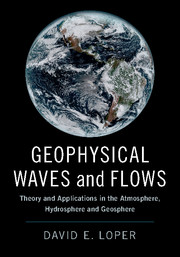Book contents
- Frontmatter
- Contents
- Preface
- Part I Introductory Material
- Part II Kinematics, Dynamics and Rheology
- 3 Kinematics of Deformation and Flow
- 4 Dynamics and the Stress Tensor
- 5 Some Thermodynamics
- 6 Shear Rheology
- 7 Static State and Perturbations
- 8 Introduction to Rotating Fluids
- Part III Waves in Non-Rotating Fluids
- Part IV Waves in Rotating Fluids
- Part V Non-Rotating Flows
- Part VI Flows in Rotating Fluids
- Part VII Silicate Flows
- Part VIII Fundaments
4 - Dynamics and the Stress Tensor
from Part II - Kinematics, Dynamics and Rheology
Published online by Cambridge University Press: 26 October 2017
- Frontmatter
- Contents
- Preface
- Part I Introductory Material
- Part II Kinematics, Dynamics and Rheology
- 3 Kinematics of Deformation and Flow
- 4 Dynamics and the Stress Tensor
- 5 Some Thermodynamics
- 6 Shear Rheology
- 7 Static State and Perturbations
- 8 Introduction to Rotating Fluids
- Part III Waves in Non-Rotating Fluids
- Part IV Waves in Rotating Fluids
- Part V Non-Rotating Flows
- Part VI Flows in Rotating Fluids
- Part VII Silicate Flows
- Part VIII Fundaments
Summary
In the previous chapter we investigated the ways in which a continuous body can deform and move. These deformations and motions are induced by three types of forces acting on the body, as explained in § 4.1. This chapter focuses on the quantification of the internal contact force, F C, and its relation to the stress tensor, denoted by S. The stress tensor describes the state of stress within a continuous body as explained in § 4.2; it is the dynamic counterpart to the strain and rate-of-strain tensors of kinematics.
In the study of kinematics and dynamics, we have many choices. For example, in kinematics we are free to choose the location and orientation of our reference coordinate system. This system may be inertial or non-inertial; it may be arbitrarily oriented or aligned with the principal axes of the strain or rate-of-strain tensor. Similarly, in dynamics we are free to define what is meant by a body. Most of the time, we think of a body as a complete physical entity, with a physically defined boundary. However, we are free to define as a “body” any arbitrary portion of a physical body, such as the parcel introduced in § 1.2. We will use this freedom to our advantage in what follows. In the process of defining an arbitrary portion of a physical body as a “body,” we must of necessity define its surfaces. The stresses on these defined surfaces are manifestations of the internal state of stress of the body at that location.
Forces
The deformations and motions of a continuous body are induced by three types of forces acting on the body:
• Body forces, denoted by FB , are applied directly to each internal particle of the body. Examples of body forces are the gravitational and electromagnetic (Lorentz) forces. The body force due to gravity is a known constant when studying the atmosphere or oceans and is a prescribed function of radius when studying mantle convection.
• Virtual forces, denoted by FV , arise from the use of a non-inertial frame of reference that is either accelerating, rotating or both. Examples of virtual forces are the centrifugal force due to the use of a rotating coordinate system and the Coriolis force, due to motion observed in a rotating frame of reference.
Information
- Type
- Chapter
- Information
- Geophysical Waves and FlowsTheory and Applications in the Atmosphere, Hydrosphere and Geosphere, pp. 35 - 47Publisher: Cambridge University PressPrint publication year: 2017
